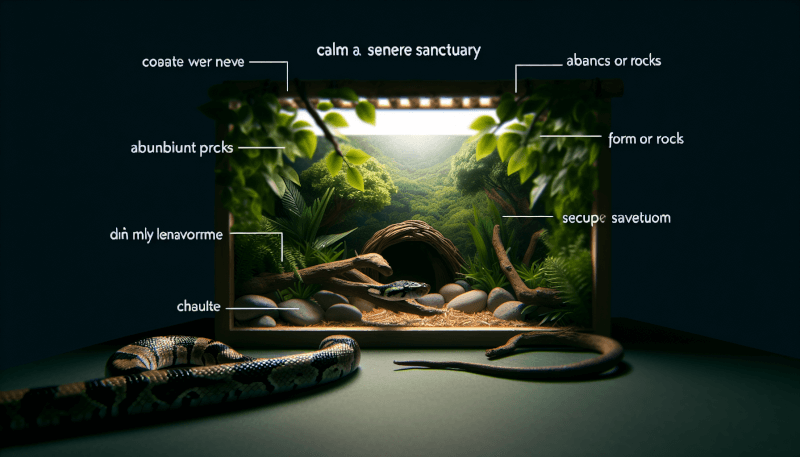Moving to a new habitat can be a stressful experience for a snake. Whether you are a seasoned snake owner or new to the world of reptiles, it is important to understand the best ways to minimize stress during these changes. In this article, you will discover practical tips and techniques to help your snake adjust smoothly to its new environment, ensuring a happy and healthy transition. From providing a comfortable temporary enclosure to gradually introducing the new habitat, these strategies will help minimize stress and ensure a seamless transition for your scaly friend.
1. Proper Planning for Habitat Changes
1.1 Understanding the Snake’s Natural Habitat
When planning for a habitat change for your snake, it is crucial to have a solid understanding of its natural habitat. Research the specific species and learn about its natural environment, including temperature, humidity, lighting, substrate, and hiding places. This information will serve as a guide when creating the new habitat to ensure that it closely resembles the snake’s natural surroundings.
1.2 Researching the Ideal New Habitat
After understanding the snake’s natural habitat, it’s important to research and identify the ideal new habitat. Consider factors such as enclosure size, heating and lighting equipment, suitable substrate, and the availability of hiding places and enrichments. Research different options and consult with reputable sources to ensure that the new habitat meets the snake’s needs.
1.3 Preparing the New Habitat Before Relocation
Before relocating the snake to its new habitat, it is essential to prepare the enclosure properly. Clean the enclosure thoroughly to remove any dirt, debris, or bacteria that may pose a risk to the snake’s health. Set up the heating and lighting equipment, ensuring that they are functioning correctly and providing the appropriate temperature and photoperiod. Place the appropriate substrate and hiding places, ensuring that they are well-distributed throughout the enclosure. This preparation will help ease the transition for the snake to its new habitat.
2. Maintaining Similar Environmental Conditions
2.1 Temperature and Humidity
Maintaining similar temperatures and humidity levels in the new habitat is essential for the well-being of your snake. Research the specific requirements for the species and replicate those conditions as closely as possible. Monitor the temperature and humidity levels regularly to ensure they are within the appropriate range.
2.2 Lighting and Photoperiod
Lighting and photoperiod play a crucial role in a snake’s daily routine. Mimicking natural light cycles can help reduce stress and promote a healthy circadian rhythm. Use timers to provide the appropriate amount of light and darkness, which will help maintain consistency and reduce disturbances to the snake’s sleep patterns.
2.3 Substrate and Enclosure
The substrate and enclosure setup should resemble the snake’s natural habitat to the best of your ability. Research the appropriate substrate for the species, considering factors such as moisture retention, ease of cleaning, and its ability to promote natural behaviors. Ensure that the enclosure provides enough space for the snake to move comfortably and includes appropriate hiding places and climbing structures.
2.4 Hiding Places and Enrichment
Hiding places are essential for snakes as they provide security and reduce stress. Place various hiding spots throughout the enclosure to create a sense of security and mimic the snake’s natural environment. Additionally, consider adding enrichments such as branches, rocks, and artificial plants to encourage natural behaviors and provide mental stimulation.

3. Gradual Transition to New Habitat
3.1 Introducing the Snake to the New Habitat
When transitioning your snake to its new habitat, it is crucial to do so gradually. This helps the snake adjust to the new environment without feeling overwhelmed or stressed. Place the snake in a temporary container within the new habitat and allow it to explore at its own pace. Gradually introduce the snake to the enclosure by opening the temporary container and letting it venture out when ready.
3.2 Monitoring the Snake’s Behavior
During the transition period, closely monitor the snake’s behavior for signs of stress or discomfort. Observe for changes in appetite, activity level, or abnormal behavior. If you notice any concerning behaviors, consult with a herpetologist, veterinarian, or experienced snake keeper for guidance and assistance.
3.3 Adjusting Conditions as Needed
Pay attention to how the snake responds to the new habitat and make adjustments as necessary. If the temperature or humidity levels need to be fine-tuned, make the appropriate changes. Additionally, observe if the snake is utilizing the provided hiding places or if additional enrichments are needed. Continuous monitoring and adjustment will help ensure that the snake thrives in its new environment.
4. Maintaining Consistency in Handling and Feeding
4.1 Minimizing Handling During the Transition Period
During a habitat change, it is best to minimize handling to reduce stress on the snake. Allow the snake time to acclimate to its new environment before attempting to handle it. Handling too soon can disrupt the snake’s adjustment process and potentially cause undue stress.
4.2 Providing Familiar Food and Feeding Schedule
Continuity in feeding habits is crucial during a habitat change. Offer the snake its familiar food and maintain the regular feeding schedule as much as possible. Familiarity with the food and a consistent feeding routine will help the snake feel secure and minimize the stress associated with the transition.
4.3 Ensuring Adequate Hydration
Proper hydration is important for the overall health and well-being of your snake. Ensure that there is a clean and accessible water source in the new habitat. Monitor the snake’s water intake to ensure it stays adequately hydrated during the transition. Hydration plays a vital role in minimizing stress and promoting a healthy adaptation to the new habitat.

5. Minimizing Disturbances and Noise
5.1 Creating a Quiet Environment
Snakes are sensitive to disturbances and noise, so it is important to create a peaceful and quiet environment in the vicinity of their enclosure. Avoid loud noises, vibrations, and sudden movements that may startle or stress the snake. Minimizing disturbances will help the snake settle into its new habitat more comfortably.
5.2 Reducing External Stressors
In addition to avoiding disturbances and noise, take steps to reduce external stressors in the snake’s environment. Ensure that the enclosure is placed in a low-traffic area where it is less likely to be disturbed by people or other pets. By reducing external stressors, you can create a calm and relaxing environment for your snake to adjust to its new habitat.
5.3 Handling Visitors and Other Pets
Visitors and other pets can potentially cause stress to the relocated snake, so it is important to manage their interactions appropriately. Advise visitors to refrain from sudden movements or loud noises near the snake’s enclosure. Keep other pets away from the enclosure to prevent any potential stress or harm to the snake. Creating a calm and controlled environment will help ease the snake’s transition and minimize stress.
6. Observation and Intervention
6.1 Regularly Observing the Snake’s Behavior
Regularly observing your snake’s behavior is crucial during the transition period. Pay attention to its activity level, appetite, and overall behavior. Monitor for any signs of stress or health concerns. By closely observing the snake, you can address any issues promptly and provide intervention if necessary.
6.2 Recognizing Signs of Stress
It’s important to be able to recognize signs of stress in your snake. Common signs include decreased appetite, excessive hiding, abnormal behavior, or changes in physical appearance. If you notice any of these signs, it’s important to seek guidance from a herpetologist, veterinarian, or experienced snake keeper who can provide advice or intervention to help alleviate the snake’s stress.
6.3 Providing Intervention when Necessary
If you observe any signs of stress or health concerns in your snake, it is crucial to provide appropriate intervention. This may involve adjusting environmental conditions, seeking professional advice, or providing additional enrichment and mental stimulation. Prompt and appropriate intervention will aid in reducing the snake’s stress and ensuring its well-being during the transition.

7. Encouraging Natural Behaviors and Enrichment
7.1 Providing Opportunities for Exploration
Encouraging natural behaviors is essential to the well-being of your snake. Provide opportunities for exploration within the new habitat by incorporating climbing structures, branches, and other enrichments. Snakes enjoy exploring their surroundings and engaging in activities that mimic their natural behaviors, so creating an environment that facilitates this will reduce stress and promote overall happiness.
7.2 Offering Enrichment Activities
Enrichment activities can help keep your snake mentally stimulated and engaged. Consider providing puzzle toys, scent trails, or hiding some food within the enclosure to encourage foraging behavior. These activities can help prevent boredom and provide a sense of fulfillment for the snake during the transition period.
7.3 Mimicking Natural Hunting and Feeding Instincts
Incorporating activities that mimic hunting and feeding instincts can help reduce stress and promote a natural environment. For example, you can utilize feeding devices that require the snake to work for its food, such as puzzle feeders or scent trails. These activities engage the snake’s natural hunting instincts and provide mental stimulation, contributing to a smoother transition to the new habitat.
8. Seeking Professional Assistance and Advice
8.1 Consulting a Herpetologist or Vet
If you have concerns or questions regarding the transition of your snake to a new habitat, it is advisable to consult a herpetologist or veterinarian. These professionals have the knowledge and experience to provide guidance specific to your snake species. They can assess the snake’s health, offer advice on habitat setup, and recommend any necessary adjustments to ensure the snake’s well-being.
8.2 Seeking Guidance from Experienced Snake Keepers
Experienced snake keepers can provide valuable insights and advice based on their firsthand experiences. Seek out online communities, forums, or local reptile enthusiast groups to connect with knowledgeable snake keepers who can share their expertise. Engaging with experienced individuals can help you navigate the transition process and gain valuable knowledge to ensure your snake’s successful adaptation to its new habitat.
8.3 Understanding the Limitations and Risks
It is important to understand that even with proper planning and care, there are inherent risks and limitations associated with any habitat change for a snake. Each snake is unique, and individual factors such as age, health, and temperament can affect how well it adapts to the new habitat. Always be mindful of your snake’s well-being and consult appropriate professionals if you have concerns or encounter any difficulties during the transition process.

9. Regular Health Assessment
9.1 Scheduling Veterinary Check-ups
Regular veterinary check-ups are crucial to ensuring your snake’s overall health and well-being. Schedule routine examinations with a veterinarian experienced in reptile care. These check-ups allow for early detection and prevention of potential health issues, providing peace of mind and helping you address any concerns related to the snake’s transition or habitat change.
9.2 Monitoring Physical Appearance and Vitality
In addition to veterinary check-ups, it is important to monitor your snake’s physical appearance and vitality on a regular basis. Look for any changes in skin condition, weight, appetite, or activity level. Maintaining a keen eye on these factors will allow you to detect any potential health issues early on and take appropriate action to address them promptly.
10. Patience and Time for Adaptation
10.1 Allowing Adequate Time for the Snake to Settle
Adaptation to a new habitat takes time for any animal, including snakes. Be patient and allow your snake ample time to acclimate to its new surroundings. Avoid making frequent changes to the enclosure or handling the snake excessively during this period. By giving the snake time to settle, you are providing it with the opportunity to adjust comfortably and reduce stress.
10.2 Gradually Reintroducing Normal Routine
After the snake has had time to settle into its new habitat, gradually reintroduce your normal routine. This may include resuming regular feeding schedules, handling, and enrichment activities. Slowly reintroducing the snake to its normal routine will further aid in reducing stress and promoting a sense of security in the new habitat.
In conclusion, minimizing stress during habitat changes for a snake requires proper planning, understanding the snake’s natural habitat, and preparing the new habitat before relocation. Maintaining similar environmental conditions, allowing for a gradual transition, and providing consistency in handling and feeding are key factors in reducing stress. Minimizing disturbances, observation, and intervention, as well as encouraging natural behaviors and seeking professional advice, will help ensure a successful transition. Regular health assessments, patience, and time for adaptation are crucial components in minimizing stress and promoting the well-being of your snake throughout the habitat change process.



